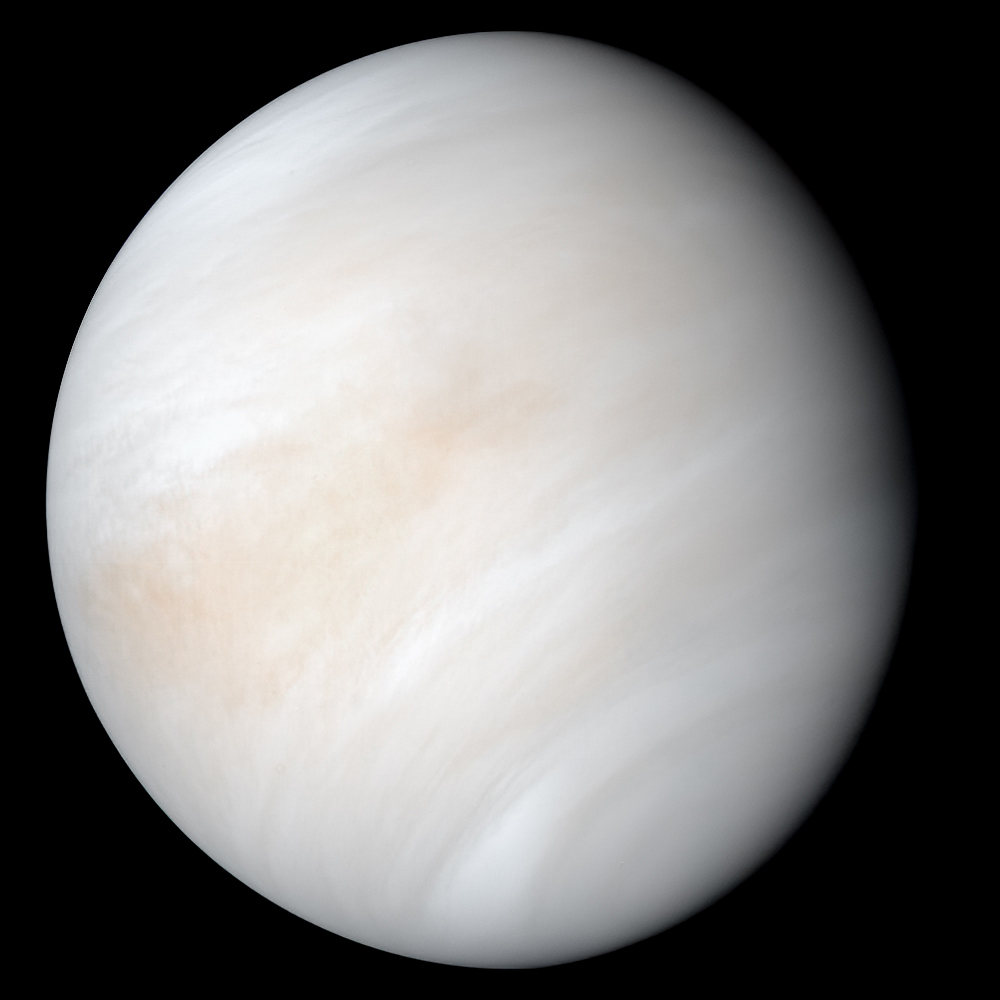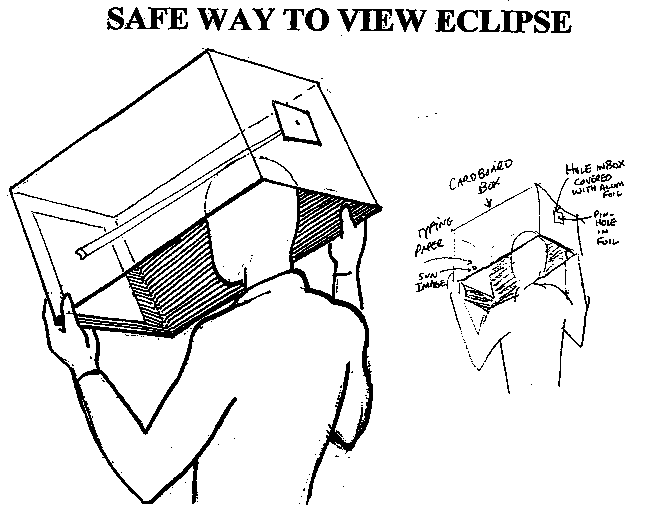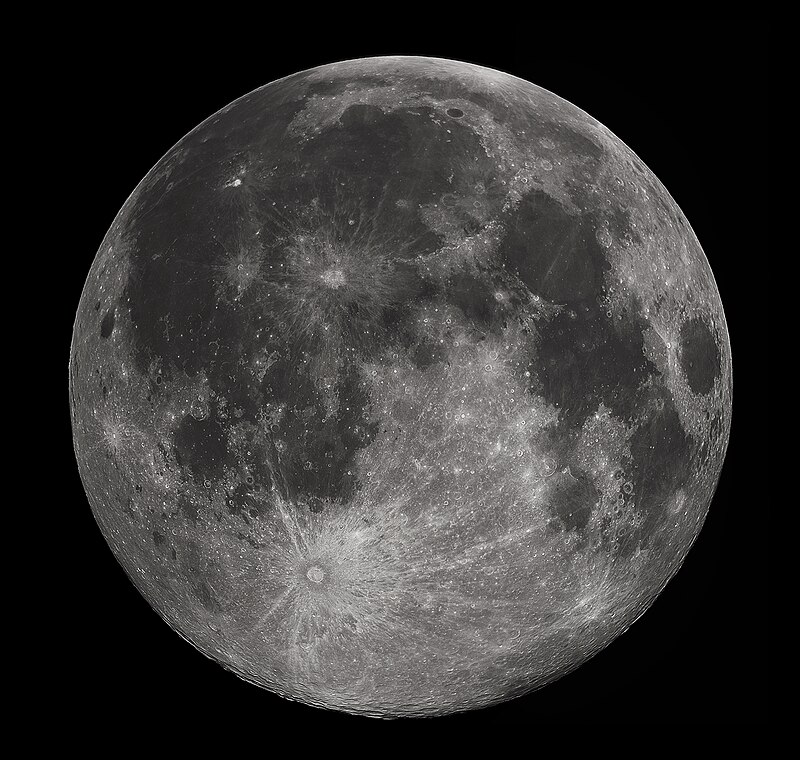
This image of the planet Venus was taken by the NASA spacecraft Mariner 10 in February of 1974, as it passed Venus at the closest distance of 3,584 statute miles / 5,768 kilometers (closest approach on 1974 February 5). Mariner 10 went on to pass planet Mercury the following month (1974 March 29) as the spacecraft became the first robotic mission to successfully fly-by more than one planet.Venus and Jupiter, the two brightest planets in the night sky, will appear very close in the morning sky this weekend.
(Image Sources: NASA, Wikipedia.org, By NASA/JPL-Caltech - https://solarsystem.nasa.gov/resources/2524/newly-processed-views-of-venus-from-mariner-10/, Public Domain, https://commons.wikimedia.org/w/index.php?curid=105847882)
By Glenn A. Walsh
Reporting for SpaceWatchtower
This weekend (Saturday & Sunday, 2022 April 30 & May 1), the two brightest planets in the night sky, Venus and Jupiter, will be in Conjunction and could appear to touch or even merge in the morning sky on Saturday and Sunday.
People can view this brilliant conjunction of the two planets, weather-permitting, low in the eastern sky, close to where the Sun will be rising, just before local Dawn. Venus will be the brighter of the two objects, about six times brighter than Jupiter. Apparent Visual Magnitude for Venus will be -4.1; for Jupiter, -2.1.
As the two points of light appear to touch, they may appear to merge into one object. Binoculars or a small telescope can be used to separate the two points of light. Both Saturday and Sunday mornings, the two planets will appear about a half-degree apart (Saturday: 0.5 degree, Sunday: 0.6 degree); this small separation can be described as less than the diameter of the Moon at the Full Moon Primary Phase (~0.5 degree).
However, both planets are moving. So, although the distance between the two planets (as seen from Earth) will be generally the same both mornings, the two planets will actually switch places from Saturday morning to Sunday morning! After the weekend, the two planets will still appear fairly close, but each day they will be moving a little farther apart.
With a reddish-orange tint, the planet Mars can be seen above and to the right of Venus and Jupiter. And, the planet Saturn can be seen above and to the right of Mars. Mars and Saturn are much fainter than Venus and Jupiter (Apparent Visual Magnitude – Mars: 0.9, Saturn: 0.8). As you look higher in the sky from east to south-east, Jupiter, Venus, Mars, and Saturn appear to form a line in the sky.
Venus is dropping down in the sky from day-to-day, as it appears to move closer to the Sun in the sky; at the same time, Venus becomes a touch fainter, but still fairly bright. You can continue to view Venus in the morning sky until late Summer. On October 22 (at 5:00 p.m. EDT / 21:00 UTC), it will pass behind the Sun (Superior Conjunction: when Venus cannot be seen, even with a telescope), and Venus can be seen in the evening sky later in the Autumn.
Currently, Jupiter is moving away from the Sun each day, in the morning sky, and becoming brighter as it gets higher in the sky. On September 26 (at 4:00 p.m. EDT / 20:00 UTC), Jupiter will be at its brightest (Apparent Visual Magnitude: -2.9) when it reaches Opposition in relation to the Sun and shines all night long.
Generally, the word Conjunction is used to describe any two celestial objects that pass close to each other. Technically, in Astronomy a Conjunction is when two objects in the sky have the same Right Ascension or the same Ecliptic Longitude, the sky coordinate systems used by astronomers. Conjunctions can occur between two planets, the Moon and a planet, or the Moon or a planet and a star. Conjunctions are a matter of the viewer's perspective. In the vast majority of cases, the two objects in Conjunction are actually great distances apart.
The actual distance between Venus and Jupiter is great. Venus, the second-closest planet to the Sun, will be 430 million statute miles / 692 kilometers from Jupiter, the fifth-closest planet to the Sun, at the time of Conjunction.
The actual Conjunction occurs on Saturday, 2022 April 30 at 3:00 p.m. Eastern Daylight Saving Time (EDT) / 19:00 Coordinated Universal Time (UTC). At that time, Venus and Jupiter appear at their closest: Venus is, then, predicted to be 0.2 degree south of Jupiter.
This Conjunction occurs a couple hours before the Primary Moon Phase of New Moon (Lunation #1229), which occurs on Saturday at 4:28 p.m. EDT / 20:28 UTC. This second New Moon in one calendar month is sometimes referred to as a Black Moon.
About the same time there will be a Partial Solar Eclipse / Partial Eclipse of the Sun visible, weather-permitting in the southern portion of South America and a small portion of Antarctica (time of Greatest Eclipse is on Saturday at 4:41:25.8 p.m. EDT / 20:41:25.8 UTC). Near the end of this blog-post is an Internet link to a blog-post describing this Partial Solar Eclipse / Partial Eclipse of the Sun. Never look directly at any Solar Eclipse / Eclipse of the Sun, unless you have the proper equipment and proper training to do so safely !
Venus appears as the brightest object in the night sky, except for the Earth's Moon, for three reasons:
Venus is shrouded in bright white, reflective clouds.
Venus is the closest planet to the Earth.
Venus is closer to the Sun than the Earth, and brightly reflects the Sun's illumination from Venus to Earth.
While just a wee bit smaller than Earth, Venus differs greatly from the Earth. The planet's atmosphere has intense heat (hottest surface of any planet in our Solar System), crushing atmospheric pressure (about 92 times the sea-level pressure of Earth), and the clouds are composed of corrosive sulfuric acid.
Although much farther away from Earth, Venus, and the Sun, Jupiter appears as the second brightest planet in the night sky due to its massive size. Jupiter is the largest planet in the Solar System, a gas giant also covered with clouds, bands and belts of clouds.
Jupiter has a mass or weight more than two-and-one-half times the mass of all the other major planets in our Solar System, combined. Jupiter is composed mostly of Hydrogen (chemical element symbol: H), along with Helium (chemical element symbol: He) being one-quarter of Jupiter's mass and one-tenth of its volume.
Internet Links to Additional Information ---
Sky Graphics of Conjunction: Link >>> https://earthsky.org/tonight/venus-and-jupiter-conjunction-april-30-may-1-2022/
Venus: Link >>> https://en.wikipedia.org/wiki/Venus
Jupiter: Link >>> https://en.wikipedia.org/wiki/Jupiter
Conjunction: Link >>> https://en.wikipedia.org/wiki/Conjunction_(astronomy)
NASA's Mariner 10 space probe: Link >>> https://en.wikipedia.org/wiki/Mariner_10
Related Blog-Post ---
Saturday: Partial Solar Eclipse Visible in South America, Antarctic." Tue., 2022 April 26.
Link >>> https://spacewatchtower.blogspot.com/2022/04/saturday-partial-solar-eclipse-visible.html
Source:
Glenn A. Walsh Reporting for SpaceWatchtower,
a project of Friends
of the Zeiss
Friday, 2022 April 29.
Like This Post? Please
Share!
More
Astronomy & Science News - SpaceWatchtower Twitter
Feed:
Link >>> https://twitter.com/spacewatchtower
Astronomy & Science Links: Link >>>
http://buhlplanetarium.tripod.com/#sciencelinks
Want to receive SpaceWatchtower blog
posts in your in-box ?
Send request to < spacewatchtower@planetarium.cc
>.
gaw
Glenn A. Walsh, Informal Science Educator &
Communicator:
Link >>> http://buhlplanetarium2.tripod.com/weblog/spacewatchtower/gaw/
Electronic
Mail: < gawalsh@planetarium.cc >
Project
Director, Friends of the Zeiss: Link >>> http://buhlplanetarium.tripod.com/fotz/
SpaceWatchtower
Editor / Author: Link >>> http://spacewatchtower.blogspot.com/
Formerly
Astronomical Observatory Coordinator & Planetarium Lecturer,
original Buhl Planetarium & Institute of Popular Science (a.k.a.
Buhl Science Center), Pittsburgh's science & technology museum
from 1939 to 1991.
Formerly Trustee, Andrew Carnegie Free Library
and Music Hall, Pittsburgh suburb of Carnegie, Pennsylvania.
Author
of History Web Sites on the Internet --
* Buhl Planetarium,
Pittsburgh: Link >>> http://www.planetarium.cc Buhl Observatory: Link >>> http://spacewatchtower.blogspot.com/2016/11/75th-anniversary-americas-5th-public.html
*
Adler Planetarium, Chicago: Link >>> http://adlerplanetarium.tripod.com
*
Astronomer, Educator, Optician John A. Brashear: Link >>> http://johnbrashear.tripod.com
*
Andrew Carnegie & Carnegie Libraries: Link >>> http://www.andrewcarnegie.cc



